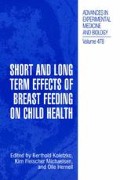Abstract
The origin of polyunsaturated fatty acids (PUFA) in human milk has not been studied in detail. Diet, liberation from maternalstores and endogenous synthesis from precursors may contribute to PUFA present in human milk. Other factors influencing lipid content and fatty acid composition such as gestational age, stage of lactation, nutritional status and genetical background are known. In a series of in vivo studies using stable isotope methodologies we investigated the metabolism of PUFA during lactation. With this techniques the transfer of single dietary fatty acids into human milk, the oxidation and the deposition in tissues were estimated. Our studies demonstrate that the major part of PUFA in human milk seems not to be derived directly from the maternal diet but from body stores. Nevertheless diet is important, because long term intakes affect composition of body stores.
Access this chapter
Tax calculation will be finalised at checkout
Purchases are for personal use only
Preview
Unable to display preview. Download preview PDF.
References
Carlson, S.E. and M. Neuringer. 1999. Polyunsaturated fatty acid status and neurodevelopment: a summary and critical analysis of the literature. Lipids 34:171–178.
Demmelmair, H., M. Baumheuer, B. Koletzko, K. Dokoupil, and G. Kratl. 1998. Metabolism of U13C-labeled linoleic acid in lactating women. J.Lipid Res. 39:1389–1396.
Fidler, N., T.U. Sauerwald, H. Demmelmair, A. Pohl, and B. Koletzko. 1999. Oxidation of an oil rich in docosahexaenoic acid compared to linoleic acid in lactating women. Ann.Nutr.Metab. (in press)
Finley, D.A., B. Lonnerdal, K.G. Dewey, and L.E. Grivetti. 1985. Breast milk composition: fat content and fatty acid composition in vegetarians and non-vegetarians. Am.J. Clin.Nutr. 41:787–800.
Francois, C.A., S.L. Connor, R.C. Wander, and W.E. Connor. 1998. Acute effects of dietary fatty acids on the fatty acids of human milk. Am.J.Clin.Nutr 67:301–308.
Genzel-Boroviczeny, O., J. Wahle, and B. Koletzko. 1997. Fatty acid composition of human milk during the first month after term and preterm delivery. Eur.J.Pediatr. 156:142–147.
Hachey, D.L., M.R. Thomas, E.A. Emken, C. Garza, L. Brown-Booth, R.O. Adlof, and P.D. Klein. 1987. Human lactation: maternal transfer of dietary triglycerides labeled with stable isotopes. J.Lipid Res. 28:1185–1192.
Harzer, G., M. Haug, I. Dietrich, and P.R. Gentner. 1983. Changing patterns of human milk lipids in the course of the lactation and during the day. Am.J.Clin.Nutr 37:612–621.
Innis, S.M. and H.V. Kuhnlein. 1988. Long-chain n-3 fatty acids in breast milk of Inuit women consuming traditional foods. Early Hum.Dev. 18:185–189.
Koletzko, B. 1992. Fats for brains. Eur.J.Clin.Nutr. 46:S51–S62
Koletzko, B., H. Demmelmair, W. Hartl, A. Kindermann, S. Koletzko, T.U. Sauerwald, and P. Szitanyi. 1998. The use of stable isotope techniques for nutritional and metabolic research in paediatrics. Early Hum.Dev. 53:S77–S97
Koletzko, B. and M. Rodriguez-Palmero. 1999. Polyunsaturated fatty acids in human milk and their role in early infant development. J.Mammary Gland Biol.Neoplasia 4:269–284.
Koletzko, B., I. Thiel, and P.O. Abiodun. 1992. The fatty acid composition of human milk in Europe and Africa. J.Pediatr. 120:62–70.
Makrides, M., M.A. Neumann, and R.A. Gibson. 1996. Effect of maternal docosahexaenoic acid (DHA) supplementation on breast milk composition. Eur.J.Clin.Nutr. 50:352–357.
Makrides, M., K. Simmer, M.A. Neumann, and R.A. Gibson. 1995. Changes in the polyunsaturated fatty acids of breast milk from mothers of full-term infants over 30 wk of lactation. Am.J.Clin.Nutr 61:1231–1233.
Muskiet, F.A.J., N.H. Hutter, I.A. Martini, J.H. Jonxis, P.J. Offringa, and E.R. Boersma. 1987. Comparison of the fatty acid composition of human milk from mothers in Tanzania, Curacao and Surinam. Hum.Nutr.Clin.Nutr. 41:149–159.
Rodriguez-Palmero, M., B. Koletzko, C. Kunz, and R. Jensen. 1999. Nutritional and biochemical properties of human milk: II Lipids, micronutrients and bioactive factors. ClinPerinatol. 26:335–359.
Sanders, T.A.B., F.R. Ellis, and J.W.T. Dickerson. 1978. Studies of vegans: the fatty acid composition of plasma choline phosphoglycerides, erythrocytes, adipose tissue and breast milk and some indicators of susceptibility to ischemic heart disease in vegans and omnivore controls. Am.J.Clin.Nutr. 31:805–813.
Sanders, T.A.B. and S. Reddy. 1992. The influence of a vegetarian diet on the fatty acid composition of human milk and the essential fatty acid status of the infant. J.Pediatr. 120:S71–S77
Sauerwald, T.U., D.L. Hachey, C.L. Jensen, H.M. Chen, R.E. Anderson, and W.C. Heird. 1997. Intermediates in endogenous synthesis of C22:603 and C20:406 by term and preterm infants. Pediatr.Res. 41:183–187.
Sprecher, H., D.L. Luthria, B.S. Mohammed, and S.P. Baykousheva. 1995. Reevaluation of the pathways for the biosynthesis of polyunsaturated fatty acids. J.Lipid Res. 36:2471–2477.
Thompson, B.J. and S. Smith. 1985. Biosynthesis of fatty acids by lactating human breast epithelial cells: an evaluation of the contribution to the overall composition of human milk fat. Pediatr.Res. 19: 139–143.
Valentine, C.J., N.M. Hurst, and R.J. Schanler. 1994. Hindmilk improves weight gain in low-birth-weight infants fed human milk. J.Pediatr. Gastroenterol.Nutr. 18:474–477.
Author information
Authors and Affiliations
Editor information
Editors and Affiliations
Rights and permissions
Copyright information
© 2002 Kluwer Academic Publishers
About this chapter
Cite this chapter
Sauenvald, T.U., Demmelmair, H., Fidler, N., Koletzko, B. (2002). Polyunsaturated Fatty acid Supply with Human Milk. In: Koletzko, B., Michaelsen, K.F., Hernell, O. (eds) Short and Long Term Effects of Breast Feeding on Child Health. Advances in Experimental Medicine and Biology, vol 478. Springer, Boston, MA. https://doi.org/10.1007/0-306-46830-1_24
Download citation
DOI: https://doi.org/10.1007/0-306-46830-1_24
Publisher Name: Springer, Boston, MA
Print ISBN: 978-0-306-46405-8
Online ISBN: 978-0-306-46830-8
eBook Packages: Springer Book Archive

